La aerodinámica en la Fórmula 1 de 2022 y de 2008 — Aerodynamics in 2022 and 2008 [ESP-ENG] #F1
Casi todos los equipos de la Fórmula 1 han presentado ya el auto con el que competirán en la temporada 2022. Desde Red Bull hasta Alpine (el cual se presentó día de hoy), solo nos quedaría presenciar lo que será el nuevo auto de la escudería Alfa Romeo, el cual será revelado en los próximos días. Hemos podido ver a lo largo de los últimos días el diseño de los diferentes equipos, y aunque hay ciertas diferencias entre ellos, hay algo que todos tienen en común, lo cual, a mi visión, nos conecta a lo que fue la Fórmula 1 de hace 14 años (año 2008).
Almost all Formula 1 teams have already unveiled their car for the 2022 season. From Red Bull to Alpine (which was presented today), we only have to witness what will be the new car of the Alfa Romeo team, which will be unveiled in the coming days. We have been able to see over the last few days the design of the different teams, and although there are certain differences between them, there is something they all have in common, which, in my opinion, connects us to what Formula 1 was 14 years ago (2008).
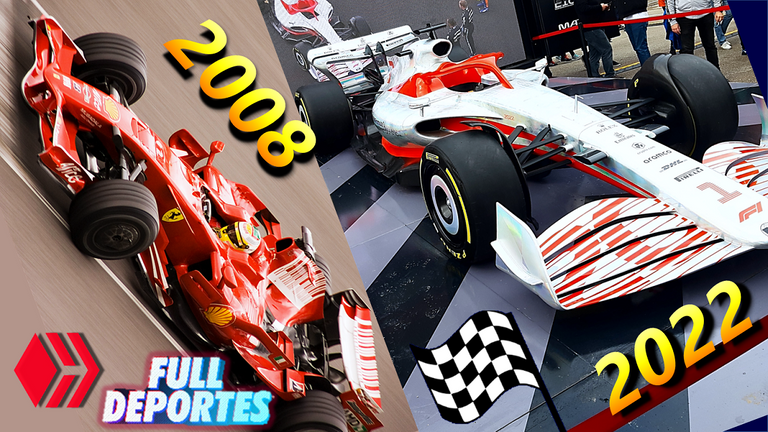
Para ver los diferentes autos que cada escudería ha presentado hasta ahora, recomiendo revisar el blog de @greengalletti, quien nos trae un análisis de lo que cada equipo tiene para dar en esta temporada 2022, la cual inicia en marzo. Este año marca el inicio de una nueva era en la Fórmula 1, propiciada por cambios en la Normativa por parte de la FIA. Los autos tendrán un nuevo diseño. Un nuevo concepto, con el objetivo de incrementar el espectáculo. Algo similar se había hecho ya en el año 2009, cambiando radicalmente el aspecto de los autos respecto a lo que había sido hasta el año 2008.
Desde 2009 hasta 2013, el diseño de los autos fue evolucionando paulatinamente. Durante la era híbrida (2014-2021), el diseño de los autos se mantuvo relativamente igual, a excepción por algunos cambios introducidos en 2017. Al llegar a 2022 nos encontramos con un nuevo escenario, diseños nuevos, con el objetivo de reducir la dificultad para adelantar a otro auto en pista. Reducir la turbulencia o "aire sucio" que se genera detrás de los autos al ir a tan altas velocidades.
To see the different cars that each team has presented so far, I recommend checking the blog of @greengalletti, who brings us an analysis of what each team has to give in this 2022 season, which starts in March. This year marks the beginning of a new era in Formula 1, brought about by changes in the Regulations by the FIA. The cars will have a new design. A new concept, with the aim of increasing the spectacle. Something similar had already been done in 2009, radically changing the look of the cars with respect to what had been until 2008.
From 2009 to 2013, the design of the cars gradually evolved. During the hybrid era (2014-2021), the design of the cars remained relatively the same, except for some changes introduced in 2017. Going into 2022 we are faced with a new scenario, new designs, with the goal of reducing the difficulty of overtaking another car on track. Reduce the turbulence or "dirty air" that is generated behind the cars when going at such high speeds.

Pero lo que podría parecer un nuevo concepto o diseño, tiene, a mi modo de ver, ciertas similitudes o influencias con los diseños que existieron hasta el año 2008 (sobre todo en 2007 y 2008). Podría decirse que los autos de Fórmula 1 de 2022 son una combinación de 3 conceptos: los alerones delantero y trasero de 2008, la aerodinámica de 2009, y el concepto general que se arrastra de la era híbrida (2021).
Si bien existen ciertas diferencias entre los distintos autos presentados hasta ahora y el prototipo de la FIA presentado el año pasado, no fue sino hasta que el nuevo Aston Martin rodó en pista que pude evidenciar ciertas características. Las imágenes del AMR22 rodando en Silverstone nos mostró algo que no se veía en la Fórmula 1 desde el año 2008:
But what might appear to be a new concept or design, has, in my view, certain similarities or influences with the designs that existed until 2008 (especially in 2007 and 2008). It could be said that the Formula 1 cars of 2022 are a combination of 3 concepts: the front and rear wings of 2008, the aerodynamics of 2009, and the general concept carried over from the hybrid era (2021).
While there are some differences between the various cars presented so far and the FIA prototype presented last year, it was not until the new Aston Martin rolled on track that I could evidence certain features. The images of the AMR22 running at Silverstone showed us something that has not been seen in Formula 1 since 2008:
Alerones delanteros altosHigh front wings
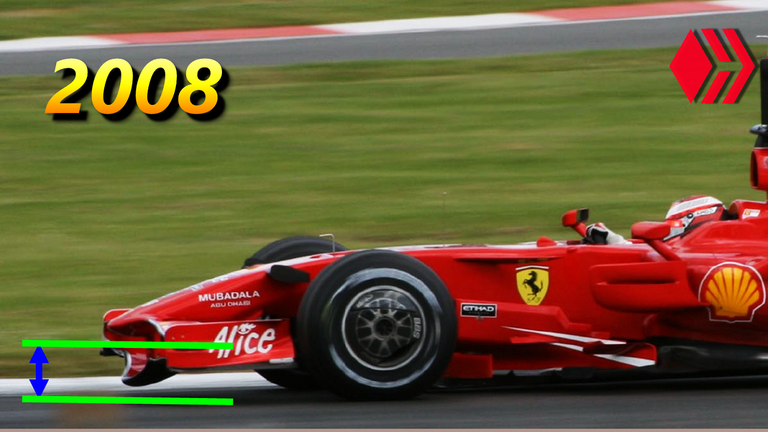
2022 Aston Martin:
Es agradable ver a la Fórmula 1 retomar ciertos conceptos de temporadas antiguas. Los cambios de 2009 quizás no dieron el resultado esperado, modificando la estética visual de los autos (que en mi opinión, empeoró en 2009). La introducción de alerones delanteros altos nos recuerda a aquellos autos del 2008. Es como si la FIA diera vuelta atrás para combinar aspectos aerodinámicos vigentes hace más de 10 años con otros actuales.
Pero si detallamos los nuevos autos de 2022, podemos notar que Aston Martin es quizás el equipo que ha presentado el alerón delantero más alto. Por otro lado, McLaren nos presentó uno notablemente más bajo. Esto podría variar de cara a la primera carrera, y más aún durante el desarrollo de la temporada. Esto podría hacer que los equipos aprovechen de cierta forma la carga aerodinámica en las curvas.
Los cambios de 2009, reduciendo la altura de los alerones delanteros y hacerlos más anchos, se hicieron en parte para que los autos no perdieran carga en curva debido al aire sucio del auto de adelante. No soy experto en aerodinámica, pero creo que volver a elevarlos manteniendo el ancho podría tener efectos importantes en las curvas.
It is nice to see Formula 1 retake certain concepts from old seasons. The 2009 changes perhaps did not give the expected result, modifying the visual aesthetics of the cars (which in my opinion, got worse in 2009). The introduction of high front wings reminds us of those 2008 cars. It is as if the FIA went backwards to combine aerodynamic aspects that were in force more than 10 years ago with current ones.
But if we detail the new 2022 cars, we can notice that Aston Martin is perhaps the team that has presented the highest front wing. On the other hand, McLaren presented us with a noticeably lower one. This could vary for the first race, and even more so during the development of the season. This could allow the teams to take some advantage of downforce in the corners.
The 2009 changes, reducing the height of the front wings and making them wider, were made in part so that the cars would not lose cornering downforce due to dirty air from the car in front. I'm no aerodynamics expert, but I think raising them again while keeping the width could have significant effects in the corners.
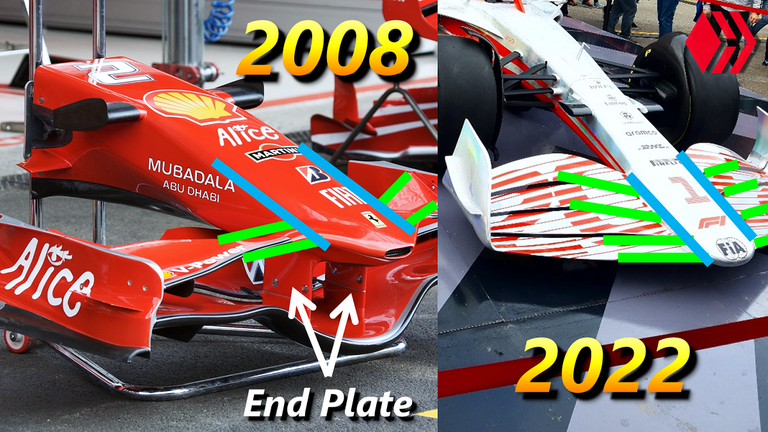
Otro aspecto similar al de 2008 en la estructura de los alerones delantero y trasero. Adelante, tenemos que los "End Plates", es decir, las placas verticales que unían el morro con el alerón delantero han desaparecido. Ahora, las aletas se unen directamente al morro por los laterales. Esto es algo muy similar a lo que ocurría en el caso del Ferrari F2008, donde el ala superior se unía lateralmente al morro. Además, los alerones traseros se asemejan en la curva central a los usados también por Ferrari en algunas carreras del año 2008. También se usaron alerones traseros curvos en la era híbrida, sobre todo en pistas como Hungaroring o Spa.
Another aspect similar to that of 2008 in the structure of the front and rear wings. At the front, we have the "End Plates", i.e. the vertical plates joining the nose to the front wing have disappeared. Now, the fins are attached directly to the nose from the sides. This is very similar to what happened in the case of the Ferrari F2008, where the upper wing was attached laterally to the nose. In addition, the rear wings resemble in the central curve to those also used by Ferrari in some races in 2008. Curved rear wings were also used in the hybrid era, especially at tracks such as the Hungaroring and Spa.
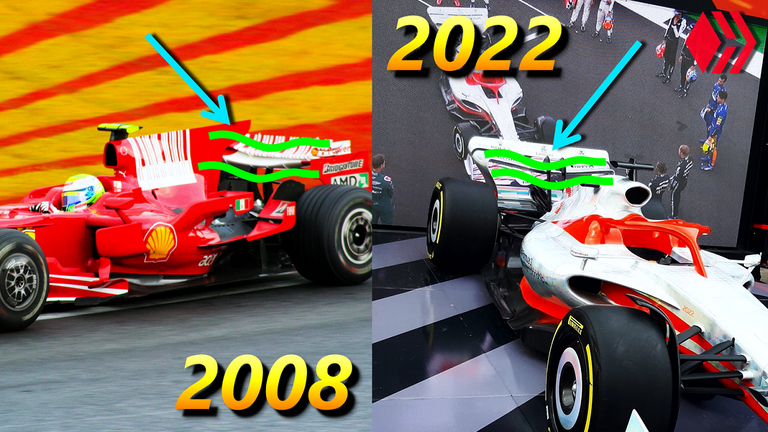
Aerodinámica de 20092009 Aerodynamics
2008:
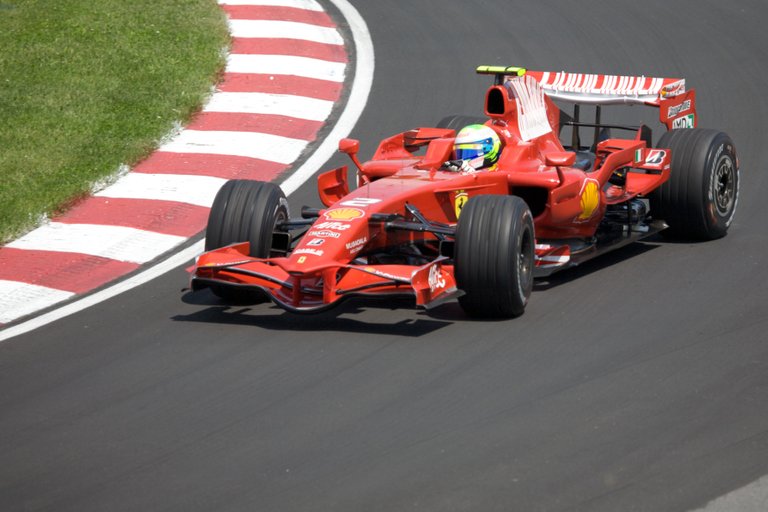
2009:
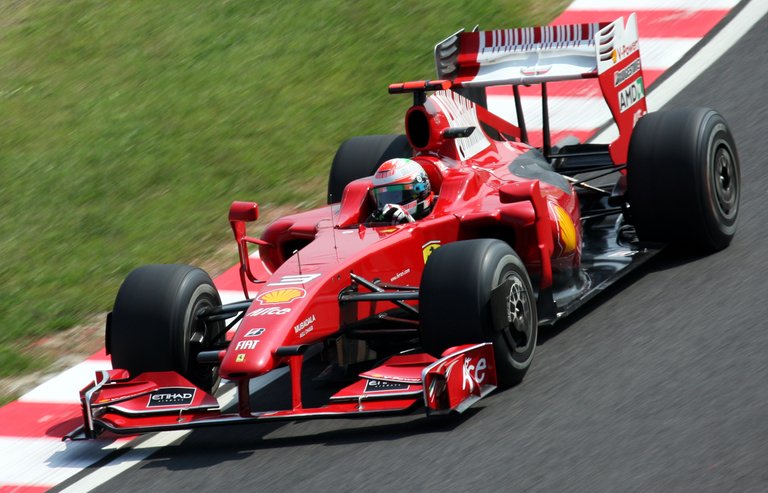
2022:
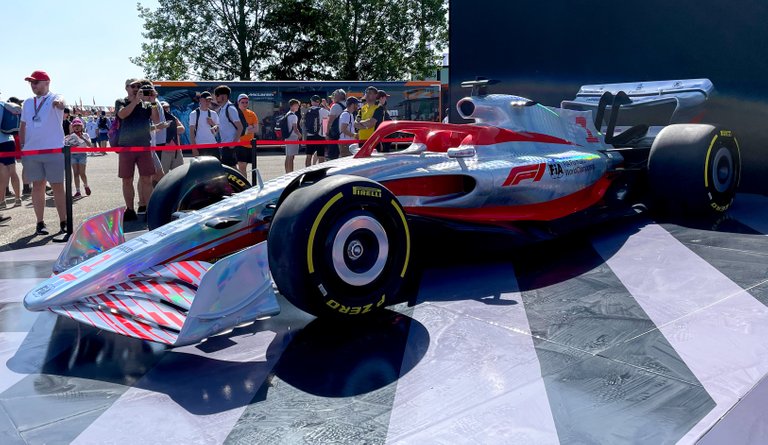
El principal cambio de la temporada 2009 respecto a la de 2008, es la eliminación casi total de mini-elementos aerodinámicos en todo el cuerpo del auto. En 2008 veíamos un montón de aletines y estructuras por todo el auto, algunos incluso con formas muy extrañas. Pero en 2009 los autos fueron "alisados", ya que estos apéndices fueron prohibidos por la FIA. Algo muy similar podemos notar en 2022. Los autos de 2022 son muy "lisos" aerodinámicamente, con el objetivo de reducir toda la turbulencia generada por estos mini-apéndices.
Aunque se eliminaron en 2009, a lo largo de 12 años, hasta 2021, estos volvieron a aparecer paulatinamente, aunque quizás en formas menos llamativas que en 2008. Lo cierto es que en 2021 estos mini-apéndices volvieron a hacerse algo notables en la mayoría de los autos. Esta es quizás una de las causas de la dificultad para adelantar en los últimos años. Pero en 2022 se busca reducir en gran medida la turbulencia generada por tantos apéndices, facilitando así el poder seguir de cerca a otro auto y adelantarle.
The main change in the 2009 season compared to 2008 is the almost total elimination of mini-aerodynamic elements all over the body of the car. In 2008 we used to see a lot of wings and structures all over the car, some of them even with very strange shapes. But in 2009 the cars were "smoothed out", as these appendages were banned by the FIA. Something very similar we can notice in 2022. The 2022 cars are very "smooth" aerodynamically, with the aim of reducing all the turbulence generated by these mini-appendages.
Although they were eliminated in 2009, over 12 years, until 2021, they gradually reappeared, although perhaps in less noticeable forms than in 2008. What is certain is that in 2021 these mini-appendices again became somewhat noticeable on most cars. This is perhaps one of the causes of the difficulty in overtaking in recent years. But in 2022 the aim is to greatly reduce the turbulence generated by so many appendages, thus making it easier to follow another car closely and overtake it.
Concepto de la era híbridaConcept of the hybrid era
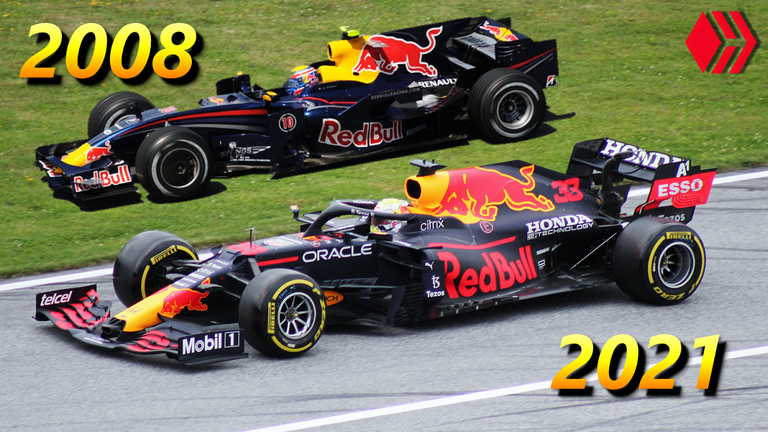
Existe una diferencia muy importante entre los autos del año 2008 y los autos actuales. Esta diferencia quizás no sea notada por el público en general, pero si por los que seguimos a la Fórmula 1 de cerca. Los autos de 2008 eran mucho más pequeños a los actuales. Los autos actuales son más largos y anchos. Sin embargo, los autos de 2022 presentan una ligera reducción de tamaño respecto a 2021. Los autos de Fórmula 1 de 2021 fueron probablemente los más grandes de la historia.
En términos generales, los nuevos autos de 2022 mantienen algunas características de la era híbrida, como los alerones delanteros muy grandes, el gran tamaño de los autos (como ya mencionamos), y otros aspectos básicos. Sin embargo, alguna característica que podríamos comparar con la época de 2008 es el morro delantero. Justamente, el equipo Ferrari ha sido el que ha presentado quizás el morro delantero más distinto al resto. Y justamente, tiene cierta similitud con el Ferrari F2008, solo que un poco más largo.
There is a very important difference between the 2008 cars and the current cars. This difference may not be noticed by the general public, but it is noticed by those of us who follow Formula 1 closely. The 2008 cars were much smaller than the current ones. Today's cars are longer and wider. However, the 2022 cars show a slight reduction in size from 2021. The 2021 Formula 1 cars were probably the largest in history.
Generally speaking, the new 2022 cars maintain some features of the hybrid era, such as the very large front wings, the large size of the cars (as already mentioned), and other basics. However, one feature that we could compare with the 2008 era is the front nose. Precisely, the Ferrari team has been the one that has presented perhaps the most different front nose from the rest. And rightly so, it has some similarity with the Ferrari F2008, only a bit longer.
Todo esto, en forma general, hace que los nuevos autos de Fórmula 1 de 2022 sean una especie de continuación del concepto de la era híbrida, pero con cambios muy importantes a nivel aerodinámico, los cuales nos recuerdan un poco a lo vivido ya en los años 2008 y 2009. También podemos encontrar otros cambios muy importantes, tales como la introducción de neumáticos más grandes, los cuales pasan de 13 pulgadas a 18 pulgadas (de diámetro interior), y de 66 a 72 centímetros de diámetro externo. En 2008, los neumáticos eran más pequeños, y con surcos rectos en lugar de lisos.
En conclusión, la temporada 2022 podría darnos muchos cambios en el dinamismo de las carreras, así como muchos cambios en la jerarquía en pista. Mercedes y Red Bull, aunque no sea tan probable, podrían perder su protagonismo frente a otros equipos como Ferrari y McLaren, o incluso podríamos ver sorpresas emerger y ser luchadores constantes por podios o victorias, tal como lo hizo Brawn GP en 2009. Por el bien de los fanáticos, el espectáculo en pista debería aumentarse gracias a estos cambios, y garantizarse una lucha reñida entre los pilotos, incluso en circuitos tradicionalmente reacios al espectáculo como Sochi o Paul Ricard.
La temporada 2009 no nos presentó un aumento significativo del espectáculo en pista. De hecho, en 2012 (al menos en la primera mitad) tuvimos una lucha muy entretenida e impredecible de varios pilotos por la victoria, y todo esto ocurrió sin la necesidad de introducir cambios tan significativos en los autos como los hechos en 2022 o 2009. Solo queda esperar al inicio de la temporada 2022 para ver que tanto cambia la Fórmula 1, y sobre todo el espectáculo en pista y lo que estos cambios puedan traer a futuro.
All this, in general, makes the new Formula 1 cars of 2022 a sort of continuation of the concept of the hybrid era, but with very important changes at the aerodynamic level, which remind us a bit of what we have already experienced in 2008 and 2009. We can also find other very important changes, such as the introduction of larger tires, which go from 13 inches to 18 inches (inside diameter), and from 66 to 72 centimeters outside diameter. In 2008, the tires were smaller, and with straight grooves instead of smooth.
In conclusion, the 2022 season could give us many changes in the dynamism of the races, as well as many changes in the on-track hierarchy. Mercedes and Red Bull, although not that probable, could lose their prominence to other teams such as Ferrari and McLaren, or we could even see surprises emerge and be constant fighters for podiums or victories, as Brawn GP did in 2009. For the sake of the fans, the spectacle on track should increase thanks to these changes, and a close fight between the drivers should be guaranteed, even at circuits traditionally averse to spectacle such as Sochi or Paul Ricard.
The 2009 season did not present us with a significant increase in on-track spectacle. In fact, in 2012 (at least in the first half) we had a very entertaining and unpredictable fight of several drivers for victory, and all this happened without the need to introduce such significant changes to the cars as those made in 2022 or 2009. It only remains to wait for the start of the 2022 season to see how much Formula 1 changes, and above all the spectacle on track and what these changes may bring in the future.
Si has leído hasta aquí, deja tu comentario o comparte (reblog) si te ha parecido interesante. ¿Qué cambios esperas para la Fórmula 1 en 2022?
If you have read this far, leave a comment or share (reblog) if you found it interesting. What changes do you expect for Formula 1 in 2022?
Translated to English with the help of DeepL.com.
| ¡Gracias por visitar! — Deja tu comentario 🚥🏆 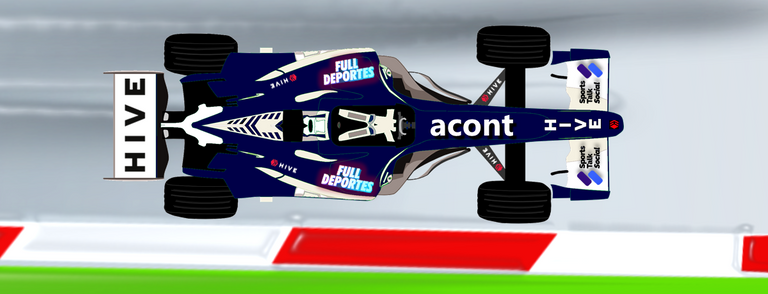 |
https://twitter.com/acontcivil/status/1495888112098099203
The rewards earned on this comment will go directly to the person sharing the post on Twitter as long as they are registered with @poshtoken. Sign up at https://hiveposh.com.
Interesantísimo post estimado amigo, te confieso que he disfrutado la lectura, la cual es muy didáctica y técnica para los que no conocemos en profundidad la F1, me gustó mucho la manera en que haces notar las diferencias en la estructura y aerodinámica de los bolidos a los cuales haces referencia , yo casi siempre que puedo disfruto ver la temporada, soy seguidor del cavallino rampante y de las balas plateadas, ahora apreciaré mejor cada carrera basado en tus excelentes consejos, gracias por compartir tan buen contenido, recibe mis saludos y afectos desde Barranquilla - Colombia. 🏎️
Saludos amigo @jakim7 gracias por tu visita! me alegro que también disfrutes de la F1, este año los autos podrían brindarnos más espectáculo en pista, y eso sería muy bueno para nosotros los fanáticos.